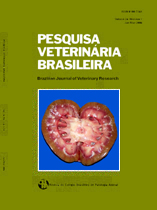 |
|
|
|
Year 2012 - Volume 32, Number 9
|

|
Acute experimental poisoning by Senecio brasiliensis in sheep and induced resistance against the poisoning, 32(9):912-916
|
ABSTRACT.- Grecco F.B., Estima-Silva P., Marcolongo-Pereira C., Soares M.P., Raffi M.B. & Schild A.L. 2012. [Acute experimental poisoning by Senecio brasiliensis in sheep and induced resistance against the poisoning.] Intoxicação experimental aguda por Senecio brasiliensis em ovinos e indução de resistência à intoxicação. Pesquisa Veterinária Brasileira 32(9):912-916. Laboratório Regional de Diagnóstico, Faculdade de Veterinária, Universidade Federal de Pelotas, Campus Universitário s/n, Pelotas, RS 96010-900, Brazil. E-mail: alschild@terra.com.br
Sheep are more resistant to poisoning by Senecio spp. than cattle and horses. To determine whether this resistance could be induced by ingestion of small and repeated doses of the plant and to know how long the resistance could last, three experiments with fresh green leaves and stalks of Senecio brasiliensis were conducted. In Experiment 1, to determine the minimum dose for acute poisoning, single doses of 60, 80, 90, 100 and 100g/kg body weight (bw) were administered to five 1 and a half-year-old male Corriedale sheep. The sheep fed 60g/kg bw and 80g/kg bw of S. brasiliensis did not get sick; however, the sheep that received 80g/kg bw, developed mild fibrosis and megalocytosis in liver biopsies performed 90, 120 and 150 days after the end of plant administration. The sheep that received 90 and 100g/kg bw showed clinical signs of anorexia, prostration, paddling movements and abdominal pain, and died 12-48 hours after the onset of clinical signs. At their necropsy, ascites, disseminated petechiae and accentuated lobular pattern of the liver were found, and histologicaly hemorrhagic centrilobular necrosis was observed. In Experiment 2, the dose of 100g/kg bw fractionated into 2, 5 and 10 daily doses was administered to three sheep respectively. The fractioned dosage did not cause clinical signs of poisoning in any of the sheep, but periportal fibrosis and moderate megalocytosis were observed in liver biopsy performed at day 60 after the end of the plant administration. No histological lesions were observed in hepatic biopsies of sheep that received 10 daily doses of 10g/kg bw. In Experiment 3, to determine whether the sheep become resistant to the acute form of poisoning, four sheep ingested daily doses of 15g/kg bw of S. brasiliensis during 30 days and daily doses of 30g/kg bw for 10 days. On the day following the last dose of 30g/kg bw, two sheep were challenged with 100g/kg bw of the plant in a single dose. No clinical signs were observed in both sheep and no histological lesions could be found in the liver biopsies obtained 15 and 30 days after administration of the challenge dose. The third and fourth sheep received the challenge dose (100g/kg bw) 15 and 45 days after the end of plant administration. These animals showed anorexia, abdominal pain, and died about 12 hours after the onset of clinical signs. Gross and microscopic lesions were similar to those observed in sheep from Experiment 1. The results of this study demonstrate that sheep are susceptible to acute S. brasiliensis poisoning at doses of 90 and 100g/kg bw, but they become resistant after the continuous ingestion of small daily doses. This resistance has been lost 15 days after the end of the plant ingestion. Natural acute poisoning by S. brasiliensis probably does not occur in sheep, because they would have to eat large amounts of the plant in a short period of time. |
| |
|
|
| |
|
 |